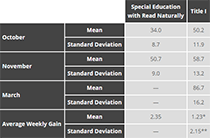Additional Studies and Reviews
Well-designed studies that implement Read Naturally interventions with fidelity consistently demonstrate the programs' effectiveness.
 Evidence-Based Read Naturally Strategy Studies | Additional Read Naturally Strategy Studies | Reviews of Read Naturally | Word Warm‑ups Studies | Take Aim at Vocabulary Studies
Evidence-Based Read Naturally Strategy Studies | Additional Read Naturally Strategy Studies | Reviews of Read Naturally | Word Warm‑ups Studies | Take Aim at Vocabulary Studies
Additional Read Naturally Strategy Studies
 | Nickodem, K. and Dupuis, D. (2017). New findings on Read Naturally Live. |
.png) | Heistad, D. (2004). The effects of Read Naturally on fluency and reading comprehension (two-school study). |
 | Johnson, G. and Weaver, J. Special Education Students, Grades 3 through 8, Huron County, MI |
 | Ihnot, C. and Marston, D. (1990). Using teacher modeling and repeated reading to improve the reading performance of mildly handicapped students. |
Reviews of Read Naturally
Top reading research organizations, including the National Center on Intensive Intervention (NCII), Florida Center for Reading Research (FCRR), and University of Oregon, have given high marks to Read Naturally Strategy programs based on reviews of studies and the program itself. However, some reviewers such as the What Works Clearinghouse have drawn inappropriate conclusions after reviewing studies that were not intended to evaluate the effectiveness of Read Naturally or where the Read Naturally program was not used with fidelity.
- University Study of Read Naturally Gets High Rating From NCII
- FCRR and U of Oregon Give Read Naturally Highest Ratings
- Chart Comparing WWC, FCRR, University of Oregon, and NCRTI
- Hancock Study Author States Study Was Not Intended to Evaluate Read Naturally
- Review of Kemp Study Deceives Educators
Word Warm-ups Studies
| Study | Type | Description |
|---|---|---|
| Study 1: Word Warm-ups and Read Naturally | Case Study | Students in a regular fourth-grade classroom and in a fourth-grade reading lab who used Word Warm-ups combined with Read Naturally’s fluency program showed greater gains in word recognition and fluency than students in a control group. |
| Study 2: Word Warm-ups and Read Naturally | Case Study | Students in a fourth-grade reading lab who worked in Word Warm-ups 2 and 3 in combination with Read Naturally Masters Edition or Take Aim at Vocabulary displayed greater gains in phonics skills and fluency than students in a control group. |
Take Aim at Vocabulary Studies
| Study | Type | Description |
|---|---|---|
| Take Aim Study 1: Minneapolis, MN | Control Group Study | Students who worked in the Take Aim curriculum for 12 weeks made significantly greater gains in vocabulary than students in a control group and demonstrated that they retained their gains in a delayed posttest. |
| Take Aim Study 2: Minneapolis, MN | Control Group Study | Students from two fourth-grade classrooms who worked in the Take Aim curriculum for 12 weeks made significantly greater gains in vocabulary than students in a control group and demonstrated that they retained their gains in a delayed posttest. |
| Take Aim Study 3: Cumming, GA | Case Study | Students from a fourth-grade classroom who worked in the Take Aim curriculum for 12 weeks made significant gains in vocabulary and demonstrated that they retained their gains in a delayed posttest. |
| Take Aim Study 4: Hazen, ND | Case Study | A group of four fifth-grade Title I students who worked in the Take Aim curriculum for 10 weeks made significant gains in vocabulary. |
Research Topics
- Read Naturally Strategy (Evidence-Based)
- Essential Components of Reading
- Research Basis of Intervention Programs
- Challenges We Address
- Evidence-Based Studies
- Additional Studies and Reviews
- Alignment With Recommended Practices
- Technical Adequacy of Assessments
Research Documents in the Knowledgebase
- Read Live Research Overview (PDF)
- Read Naturally Rationale & Research (PDF)
- Word Warm-ups Rationale & Research (PDF)
- Take Aim at Vocabulary Research & Rationale (PDF)
- White Paper: Foundational Reading Skills (PDF)
- White Paper: Developing Fluent Readers (PDF)
- White Paper: Dyslexia and Read Naturally (PDF)
- White Paper: Comprehension Support for ELLs Using the Read Naturally Strategy (PDF)
- White Paper: Differentiating Instruction (PDF)
- White Paper: Foundational Skills K‐5 Common Core State Standards (PDF)
- All research documents
Please let us know what questions you have so we can assist. For Technical Support, please call us or submit a software support request.